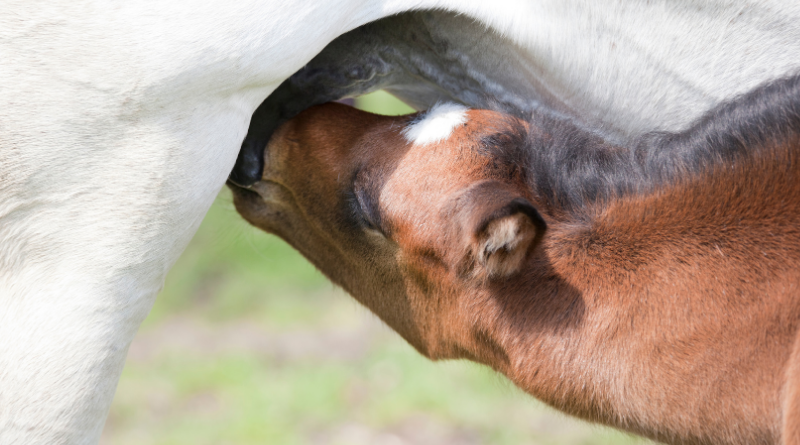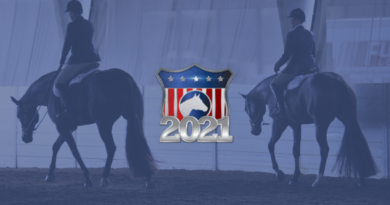Colic and Diarrhea in Foals: Symptoms and Causes
Young foals are susceptible to colic, diarrhea and other gastrointestinal issues. These are the symptoms and when to intervene.
Meconium impaction, ulcers and parasites are among the conditions that can cause colic in foals. At the forefront of these problems are gastrointestinal issues, which can produce severe abdominal pain (colic) and even death.
Colic in foals often develops quickly. Because of the foal’s delicate GI system, it is important to take signs of even very mild colic seriously, because it could progress to a life-threatening condition in a few hours.
Symptoms of Colicking Foals
Symptoms of colic in foals include restlessness and straining to defecate, lying down and getting up frequently, teeth grinding and rolling on the back. As the condition worsens, symptoms might become more violent and frequent. Conditions that cause colic in foals during the first few weeks of life include bacteria- and virus-caused diarrhea, parasites, meconium impaction and ulcers.
Meconium is the first feces that is passed by the foal and can impact in the colon during the first two to three days of life. This condition is especially prevalent in foals that have not nursed well or are weak. Signs are a rapid onset, tail flagging and straining to defecate. The foal can become bloated, extremely pained and dehydrated. Diagnosis is made by digital examination of the rectum, ultrasound or abdominal radiographs. The administration of Fleet or mild dish soap enemas is effective early in the course of the disease. However, repeated enemas can damage the foal’s rectal lining and cause electrolyte imbalances. More severe cases might require oral laxatives, pain medication and fluids for rehydration. This condition can usually be prevented by administering a 4-ounce Fleet enema to foals soon after birth.
Diarrhea can be a serious problem in foals, especially diarrhea caused by rotavirus or clostridial bacteria. Clostridial interocolitis usually strikes foals from a few days to 3 months of age. First signs are decreased appetite and depression, with colic, diarrhea that might contain blood, abdominal distention and fever to quickly follow. Affected foals should be hospitalized as soon as possible and treated aggressively with intravenous fluids and antibiotics.
Rotavirus causes a foul-smelling diarrhea, depression, loss of appetite, dehydration and fever. Treatment consists of supportive therapy, such as IV fluids administered to prevent dehydration. Because rotavirus is a virus, antibiotics are not effective and should not be administered. Rotavirus can be prevented by vaccinating broodmares during the eighth, ninth and 10th months of gestation.
Foal Heat Diarrhea
Foal-heat diarrhea is a term that describes diarrhea (“scours”) that occurs in newborn foals. The condition received its name because it usually occurs while the mare is experiencing her first estrous cycle (called the foal heat) after foaling.
Veterinarians still are not sure what exactly causes foal heat diarrhea. Originally, mare owners and veterinarians thought diarrhea resulted from hormonal changes in the mare during estrus or changes in the composition of her milk. However, orphaned foals also develop diarrhea about the same time after birth. Other potential causes that have been investigated include the worm parasite Strongyloides westeri (threadworms), which is transmitted from the mare’s udder to the foal via her milk. This parasite used to be found in about 90 percent of foals, but the increased use of new dewormers has lowered the incidence to less than 6 percent without a corresponding decrease in the incidence of foal-heat diarrhea. Some owners believe that coprophagy (eating manure), which is common in newborn foals, is the cause, but this is a normal activity designed to help the foal populate his intestine with helpful bacteria. Horses cannot digest the cellulose portion of grass and hay without the aid of bacteria. Because foals are born without bacteria in their intestine, they must acquire them. Their mother’s manure is the best source.
Although the cause of foal-heat diarrhea is still not definitively known, probably the best explanation is that it is the result of rapid maturation changes in the intestinal tract of the foal that interfere with the intestine’s ability to reabsorb fluids. The result is transient, watery diarrhea.
Foal-heat diarrhea usually results in only a mildly loose or slightly watery diarrhea that resolves itself without treatment. Foals remain bright, alert and active and continue to nurse. This is in contrast to infectious (viral or bacterial) diarrhea, which causes the foal to be depressed, refuse to nurse, run a fever and experience profuse, often foul-smelling diarrhea.
Differences in Diarrhea
There are several ways to tell the difference between the two types of diarrhea.
First, take the foal’s temperature to see if he has a fever. Foals with foal-heat diarrhea will have a normal temperature of 99-101.5 degrees Fahrenheit, while foals with infectious diarrhea will have an elevated temperature. (Learn how to successfully take a foal’s temperature.)
Second, make sure the foal is nursing. Foal-heat diarrhea foals will nurse, but sick foals will not.
And finally, observe the character of the diarrhea. Foal-heat diarrhea usually produces a yellowish, pasty manure, while infectious diarrhea produces a more watery, yellow-brown diarrhea that is often foul-smelling. Foal-heat diarrhea is self-limiting and usually does not require treatment. In fact, antibiotic therapy is contraindicated and should never be used because antibiotics can kill the healthy bacteria and cause severe diarrhea. Because treatment with antibiotics can cause much more harm than good, consult a veterinarian. However, infectious diarrhea can be life threatening and might require antibiotics, intravenous fluids and antiulcer medications. A veterinarian can determine if therapy is indicated and which therapy is best.
Preventing Harm From Diarrhea
One side effect of foal-heat diarrhea is irritation caused by diarrhea running down the foal’s hind legs, which can cause painful scalding of the skin and result in hair loss. Applying petroleum jelly on both hind legs once or twice a day prevents the diarrhea from contacting the foal’s skin. If the foal’s hind legs are already covered with feces, wash the hind legs and tail with mild soap, dry with a soft towel and apply petroleum jelly. Although foal-heat diarrhea is a naturally occurring event, infectious diarrhea is not. Good farm management is key and should include the following:
- Ensure the foal receives good-quality colostrum in the first 18 hours of life.
- If rotavirus is a problem in your area, vaccinate the mare during the eight, ninth and 10th month of her gestation. She will pass on protection against the virus in her colostrum.
- Move mares to the farm where they are to foal at least six to eight weeks prior to foaling. This will give them adequate time to build up antibodies in their colostrum to local pathogens in the new environment.
- If the mare is to foal in a stall, clean the stall with phenolic disinfectants and bed it with good, clean straw.
Foal-heat diarrhea is a normal condition. However, affected foals should be monitored to ensure that infectious diarrhea or complications do not develop. Before initiating any therapy, check with a veterinarian. Foals are fragile, and unnecessary – or wrong – treatment can cause tremendous damage.




